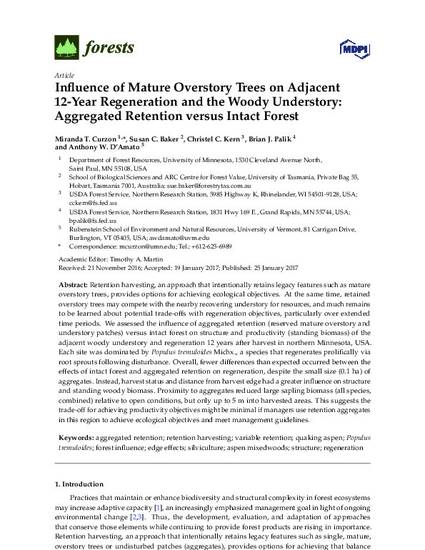
Article
Influence of Mature Overstory Trees on Adjacent 12-Year Regeneration and the Woody Understory: Aggregated Retention versus Intact Forest
Forests
(2017)
Abstract
Retention harvesting, an approach that intentionally retains legacy features such as mature
overstory trees, provides options for achieving ecological objectives. At the same time, retained
overstory trees may compete with the nearby recovering understory for resources, and much remains
to be learned about potential trade-offs with regeneration objectives, particularly over extended
time periods. We assessed the influence of aggregated retention (reserved mature overstory and
understory patches) versus intact forest on structure and productivity (standing biomass) of the
adjacent woody understory and regeneration 12 years after harvest in northern Minnesota, USA.
Each site was dominated by Populus tremuloides Michx., a species that regenerates prolifically via
root sprouts following disturbance. Overall, fewer differences than expected occurred between the
effects of intact forest and aggregated retention on regeneration, despite the small size (0.1 ha) of
aggregates. Instead, harvest status and distance from harvest edge had a greater influence on structure
and standing woody biomass. Proximity to aggregates reduced large sapling biomass (all species,
combined) relative to open conditions, but only up to 5 m into harvested areas. This suggests the
trade-off for achieving productivity objectives might be minimal if managers use retention aggregates
in this region to achieve ecological objectives and meet management guidelines.
Keywords
- aggregated retention;,
- retention harvesting;,
- variable retention;,
- quaking aspen,
- Populus tremuloides,
- forest influence,
- edge effects,
- silviculture,
- aspen mixedwoods
Disciplines
Publication Date
January 25, 2017
DOI
10.3390/f8020031
Publisher Statement
© 2017 by the authors
Citation Information
Works produced by employees of the U.S. Government as part of their official duties are not copyrighted within the U.S. The content of this document is not copyrighted.
